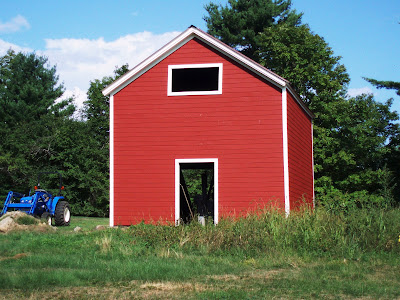We have four old dilipated barns on our property.....
....and Bob has decided to fix up the one in the worst condition first. It was a rabbit hutch and chicken coop, or at least that's what we can determine. It's the oldest, with peg and beam construction. It's also the smallest one, so you think it'd be easy, right? Hardly! Restoring an old barn doesn't seem worth it. There's so much hard work involved, it'd be much cheaper and easier to just tear them down and build anew. The wood siding was shot and the foundation, what little foundation there was, needed a complete overhaul. Literally the front of the barn sunk into the earth as it rotted away from years of harsh Adirondack weather beatings. Even the front door was immobile because it was embedded in the ground.
There's something to be said for restoring an old barn. Our society has become such a disposable society, and old barns are more of a rare novelty these days, with "exposed" barn beams all the rage in houses today. To imagine that people are buying barns for the sole purpose of tearing them down to recycle them into decorative beams, picture frames and you name it, is beyond me. An old barn, even if it is not on a historic registry, simply can never be replaced. They are a direct connection to our past and should be preserved for future generations. And who knows, pehaps someday be used as their original intention.
Ha! I say that now, but it's truly daunting how much work needs to be done before we can use this barn as a small livestock barn. Bob jacked up the barn, dug footers, and got it plumb and square, reframed portions of the beams that were rotted away, installed sill plates, and reframed as necessary. There were never any eaves on the barn, so Bob extended the roofline and build eaves. Then there were two sets of siding on the barn. Beneath the novelty siding, was an older unstained board and batten siding.
We decided to keep the board and batten underneath and reside over it with tongue and groove siding Bob found at a really good price from a local saw mill.
Then we decided to paint it instead of stain. Bob installed the trim before we painted. We soon realized it would have been much easier to paint the trim and paint the barn, then install the painted trim on top of the painted barn, instead of trying to cut in every trim board. Lesson learned!
Next up, we need to paint and install the windows and doors, and then regrade and finish the foundation. Also we need to determine whether we want to keep the dirt floor or pour a concrete floor. This is only the small barn! We have three more to go and this barn has taken us over a year to get this far.... Ahh, but we wouldn't trade a minute of it! It's satisfying to look at your work, and know that now this barn will hopefully stand for another 100 years.
Next up, we need to paint and install the windows and doors, and then regrade and finish the foundation. Also we need to determine whether we want to keep the dirt floor or pour a concrete floor. This is only the small barn! We have three more to go and this barn has taken us over a year to get this far.... Ahh, but we wouldn't trade a minute of it! It's satisfying to look at your work, and know that now this barn will hopefully stand for another 100 years.





This is such a great resource that you are providing and you give it away for free. I love seeing blog that understand the value. Im glad to have found this post as its such an interesting one! I am always on the lookout for quality posts and articles so i suppose im lucky to have found this! I hope you will be adding more in the future... Horse Barns
ReplyDelete